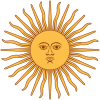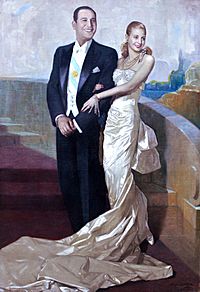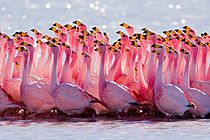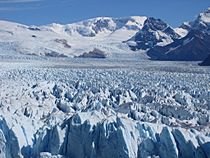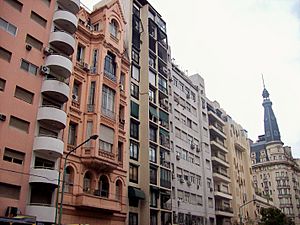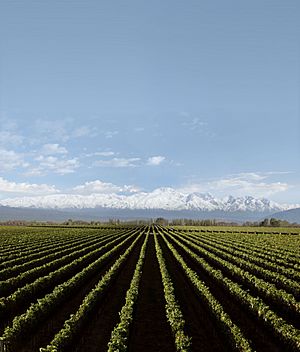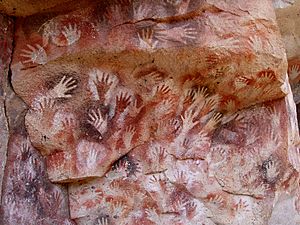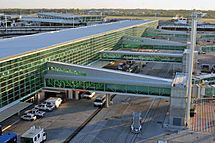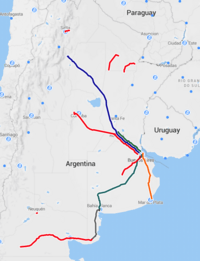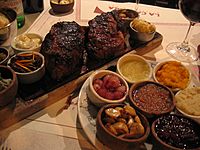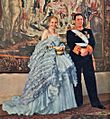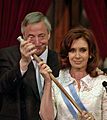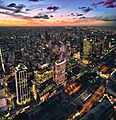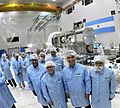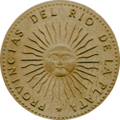Argentina facts for kids
Quick facts for kids
Argentine Republic
República Argentina (Spanish)
|
|
|---|---|
|
Motto:
|
|
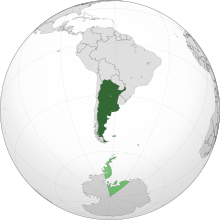
Argentine territory in dark green; territory claimed but not controlled by Argentina in light green
|
|
| Capital and largest city
|
Buenos Aires 34°36′S 58°23′W / 34.600°S 58.383°W |
| Official languages | Spanish (de facto) |
| Co-official languages |
|
| Religion
(2019)
|
|
| Demonym(s) |
|
| Government | Federal presidential republic |
| Javier Milei | |
| Victoria Villarruel | |
|
• Chief of the Cabinet of Ministers
|
Guillermo Francos |
| Legislature | National Congress |
| Senate | |
| Chamber of Deputies | |
| Independence
from Spain
|
|
| 25 May 1810 | |
|
• Declared
|
9 July 1816 |
| 1 May 1853 | |
| Area | |
|
• Total
|
2,780,400 km2 (1,073,500 sq mi) (8th) |
|
• Water (%)
|
1.57 |
| Population | |
|
• 2024 estimate
|
|
|
• 2022 census
|
|
|
• Density
|
16.6/km2 (43.0/sq mi) (178th) |
| GDP (PPP) | 2024 estimate |
|
• Total
|
|
|
• Per capita
|
|
| GDP (nominal) | 2024 estimate |
|
• Total
|
|
|
• Per capita
|
|
| Gini (2022) | ▼ 40.7 medium |
| HDI (2022) | very high · 48th |
| Currency | Argentine peso ($) (ARS) |
| Time zone | UTC−3 (ART) |
| Date format | dd/mm (CE) |
| Driving side | right |
| Calling code | +54 |
| ISO 3166 code | AR |
| Internet TLD | .ar |
|
|
|
Argentina (officially the Argentine Republic) is a large country in South America. It's the second-largest country on the continent and the eighth-largest in the world.
Most people in Argentina speak Spanish, which is the official language. However, you'll also hear other languages like Italian, German, English, Quechua, and even Welsh in a region called Patagonia.
The capital city of Argentina is Buenos Aires. It's one of the biggest cities globally, located in eastern Argentina. Other major cities include Córdoba, Rosario, Mendoza, and La Plata.
Argentina is located between the Andes mountain range to the west and the southern Atlantic Ocean to the east and south. It shares borders with Paraguay and Bolivia to the north, Brazil and Uruguay to the northeast, and Chile to the west and south. Argentina also claims the Falkland Islands (called Islas Malvinas in Spanish) and South Georgia and the South Sandwich Islands.
Contents
Argentina's Story
The name Argentina comes from the Latin word argentum, which means "silver." The Spanish explorers thought this area had a lot of silver. Argentina is one of the largest countries in the Americas, after Canada, the US, and Brazil.
The very first signs of people living in Argentina are found in Patagonia. These signs are over 13,000 years old! Around 1480, the powerful Inca Empire took over northwestern Argentina. In the northeast, the Guaraní people developed a culture based on growing plants like yuca and sweet potato. Today, popular dishes in Argentina include pasta, red wines (due to Italian influence), and beef.
Argentina declared its independence from Spain in 1816 and fully achieved it in 1818. The country grew a lot as many immigrants from Europe came to live there. By the 1920s, Argentina was one of the wealthiest countries in the world.
However, things became difficult after that. In the 1940s, after a time of political instability, Juan Perón became a very important leader. Many politicians in Argentina today still follow his ideas. Perón was forced out of power in 1955 but returned in the 1970s.
In 1976, the country faced many problems, and the military took control of the government. This had happened before in Argentina's history. One of the leaders during this time was Jorge Rafael Videla. During his time, many people disappeared or were killed.
Later, another general, Leopoldo Galtieri, became leader. By 1981, people were unhappy with the military government. To try and gain support, Galtieri ordered an invasion of the Falkland Islands, which started a war. Argentina lost the war, and the country faced more problems. Galtieri was removed from power, and eventually, democracy returned. Both Galtieri and Videla were later charged with terrible crimes for the actions they ordered.
Today, Argentina is a very important country in Latin America. It has a large economy and plays a big role in the southern part of South America.
Amazing Geography

Argentina covers a huge area of about 2,780,400 square kilometers. It's located in southern South America. It shares land borders with Chile, Bolivia, Paraguay, Brazil, and Uruguay. Its coastline along the Río de la Plata and South Atlantic Ocean is over 5,000 kilometers long.
The highest point in Argentina is Aconcagua, a mountain in the Mendoza province. It stands at 6,959 meters above sea level. This makes it the highest mountain outside of Asia and the highest point in both the Southern Hemisphere and Western Hemisphere.
The lowest point is Laguna del Carbón in the Santa Cruz province. It's 105 meters below sea level. This is also the lowest point in the Southern and Western Hemispheres, and the seventh lowest point on Earth!
Some of Argentina's major rivers include the Paraná, Uruguay, and Paraguay. These rivers flow into the Argentine Sea, which is a shallow part of the Atlantic Ocean.
Regions of Argentina
Argentina is divided into seven main geographical regions:
- Northwest: This area has high mountains and dry valleys.
- Mesopotamia: A subtropical area between the Paraná and Uruguay rivers.
- Gran Chaco: A large, low-lying plain with subtropical and tropical climates.
- Sierras Pampeanas: A series of medium-height mountain ranges in the center.
- Cuyo: A region in the central Andes foothills.
- Pampas: A huge and very fertile plain in the center-east.
- Patagonia: A large southern plateau with dry, rocky areas and cold grasslands.
Rich Nature
Argentina is a "megadiverse country." This means it has an amazing variety of ecosystems. It includes 15 different land zones, 3 ocean zones, and even an Antarctic region.
This huge variety of environments leads to incredible biological diversity. Argentina is home to:
- Over 9,300 types of vascular plants.
- Over 1,000 kinds of birds.
- Over 370 types of mammals.
- Over 330 kinds of reptilians.
- Over 160 types of amphibians.
Argentina's Climate
Argentina has many different climates, even though its most populated areas are generally temperate. The climate ranges from subtropical in the north to polar in the far south.
Rainfall varies a lot, from very dry parts of Patagonia to very wet areas in the northeast. Average yearly temperatures range from 5°C in the far south to 25°C in the north.
Important winds include the cool Pampero Winds that blow across Patagonia and the Pampas. The Sudestada brings heavy rains and rough seas, especially in late autumn and winter. The Zonda is a hot, dry wind that affects central Argentina. It can cause wildfires and damage.
People of Argentina
In 2001, Argentina had about 36 million people. By 2010, this number grew to over 40 million. Argentina has the third-largest population in South America.
Most Argentinians are descendants of Europeans, mainly from Spain, Italy, Germany, Ireland, and France. People of European descent and Mestizo (mixed European and Indigenous heritage) make up more than 90% of the population.
Argentina's Economy
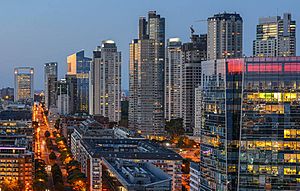
Argentina has many rich natural resources, a well-educated population, and a strong industrial base. Its economy is the third-largest in Latin America and the second-largest in South America.
Argentina is considered a middle emerging economy and is one of the world's top developing nations. It is also a member of the G-20 major economies, a group of the world's biggest economies.

What Argentina Makes
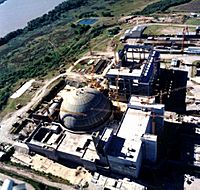
As of 2012, Argentina's main industries included:
- Food and drinks.
- Cars and car parts.
- Textiles (fabrics) and leather.
- Oil products and biodiesel.
- Chemicals and medicines.
- Steel, aluminum, and iron.
- Machinery for factories and farms.
- Home appliances and furniture.
- Plastics and tires.
- Glass and cement.
- Printing and media.
Argentina is also one of the top five wine-producing countries in the world.
Córdoba is a major industrial hub, known for metalworking and car manufacturing. The Greater Buenos Aires area is important for food processing, cars, chemicals, and textiles. Other cities like Rosario and San Miguel de Tucumán also have important industries.
Tourism in Argentina
Tourism in Argentina is popular because of its rich culture and beautiful natural places. In 2013, Argentina had over 5.5 million visitors. It was the top tourist destination in South America and second in Latin America after Mexico.
The capital city, Buenos Aires, is the most visited city in South America. Argentina also has 30 National Parks, including many World Heritage Sites in Argentina.
Top Places to See
- Iguazu Falls (a huge waterfall system)
- Teatro Colón (a famous opera house)
- Obelisk of Buenos Aires (an iconic monument)
- Cementerio de la Recoleta (a historic cemetery)
- Casa Rosada (the president's office)
- Plaza de Mayo (a historic square)
- Perito Moreno Glacier (a massive glacier)
- Cueva de las Manos (Cave of the Hands, with ancient cave paintings)
Getting Around
Argentina has the largest railway system in Latin America. As of 2008, it had over 36,000 kilometers of operating lines. This system connects all 23 provinces and links to neighboring countries.
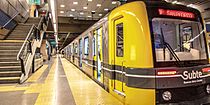
By 2004, most major cities were connected by over 69,000 kilometers of paved roads. Many important cities are now linked by a growing number of expressways.
As of 2012, Argentina had about 11,000 kilometers of waterways, mainly on the La Plata, Paraná, Paraguay, and Uruguay rivers. Buenos Aires is a very important port city.
In 2013, there were 161 airports with paved runways in Argentina.
Culture of Argentina
Argentina is a multicultural country with strong European influences. Modern Argentine culture has been shaped a lot by immigrants from Italian, Spanish, and other European countries like France, the United Kingdom, and Germany.
Cities often show European and American styles in fashion, buildings, and design. You can find many museums, cinemas, and art galleries in big cities. There are also traditional places like literary bars and bars with live music. While European influences are strong, there are also elements from Amerindian and African traditions, especially in music and art. The traditional lifestyle of the gauchos (cowboys) also plays a role.
Music and Dance

Tango is a special type of music and dance from the Rioplatense region. It has European and African influences and is one of Argentina's most famous cultural symbols around the world. The "golden age" of tango, from the 1930s to the mid-1950s, was similar to the jazz and swing era in the United States.
Buildings and Art
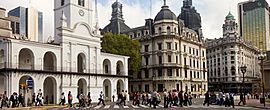
When the Spanish colonized Argentina, they brought Spanish Baroque architecture. You can still see simpler versions of this style in places like the Cathedral of Córdoba. Later, in the 19th century, Italian and French styles became popular, giving Argentine architecture a unique look.
Delicious Food
Besides many pasta, sausage, and dessert dishes common in Europe, Argentinians enjoy many local creations. These include empanadas (small stuffed pastries), locro (a hearty stew), and mate (a traditional tea-like drink).
Argentina has the highest consumption of red meat in the world. It's often prepared as asado, which is the traditional Argentine barbecue. This includes different types of meats, sausages, and other grilled items.
Common desserts are facturas (Viennese-style pastries), cakes, and pancakes filled with dulce de leche (a sweet milk caramel). You'll also find alfajores (cookies with chocolate or dulce de leche) and tortas fritas (fried cakes).
Argentine wine is considered some of the best in the world and is a big part of local meals. Popular types include Malbec, Torrontés, and Cabernet Sauvignon.
Other Fun Facts
Football (soccer) is the most popular sport in Argentina. However, the national sport is actually Pato, a game played on horseback. Argentina also has many highly ranked Polo players. Field hockey (for women), rugby, and golf are also popular.
Argentina is a Christian country, with most people (about 80%) being Roman Catholic. Argentina also has one of the largest Jewish communities outside of Israel and the US. There are also Muslim communities in the country.
See Also
Images for kids
-
The Cave of the Hands in Santa Cruz province, with artwork dating from 13,000 to 9,000 years ago.
-
The surrender of Beresford to Santiago de Liniers during the British invasions of the Río de la Plata
-
Portrait of General José de San Martin, Libertador of Argentina, Chile and Peru.
-
People gathered in front of the Buenos Aires Cabildo during the May Revolution
-
Julio Argentino Roca was a major figure of the Generation of '80 and is known for directing the "Conquest of the Desert". During his two terms as President many changes occurred, particularly major infrastructure projects of railroads; large-scale immigration from Europe and laicizing legislation strengthening state power.
-
Juan Perón and his wife Eva Perón, 1947
-
Juan Perón and his wife Isabel Perón, 1973
-
Admiral Emilio Massera, Lieutenant General Jorge Videla and Brigadier General Orlando Agosti (from left to right) – observing the Independence Day military parade on Avenida del Libertador, 9 July 1978.
-
Argentinians soldiers during the Falklands War
-
Two members of the Regiment of Mounted Grenadiers guarding the Constitution of the Argentine Nation inside the Palace of the Congress.
-
Néstor Kirchner and his wife and political successor, Cristina Kirchner
-
Aconcagua is the highest mountain outside of Asia, at 6,960.8 metres (22,837 ft), and the highest point in the Southern Hemisphere.
-
The national animal of Argentina is the Rufous hornero, a small songbird native to South America
-
Fiat factory in Córdoba, Argentina
-
Passenger train near Mar del Plata
-
President Macri in the INVAP with the SAOCOM A and B, two planned Earth observation satellite constellation of Argentine Space Agency CONAE. the scheduled launch dates for 1A and 1B were further pushed back to 2018 and 2020.
-
Dialectal variants of the Spanish language in Argentina
-
Francis, the first pope from the Americas, was born and raised in Argentina.
-
Faculty of Law of the University of Buenos Aires
-
El Ateneo Grand Splendid was named the second most beautiful bookshop in the world by The Guardian.
-
Four of the most influential Argentine writers. Top-left to bottom-right: Julio Cortázar, Victoria Ocampo, Jorge Luis Borges and Adolfo Bioy Casares
-
Martha Argerich, widely regarded as one of the greatest pianists of the second half of the 20th century
-
Teatro Colón, ranked the third best opera house in the world.
-
Andy Muschietti, director of It, the highest-grossing horror film of all-time.
-
Diego Maradona, one of the FIFA Player of the 20th Century
-
Lionel Messi, seven times Ballon d'Or winner, is the current captain of the Argentina national football team.
See also
 In Spanish: Argentina para niños
In Spanish: Argentina para niños




